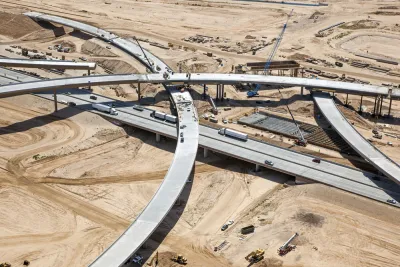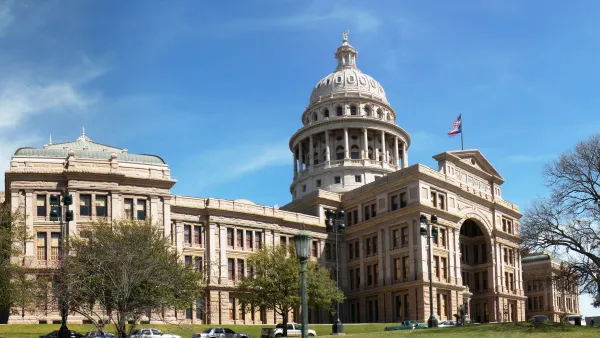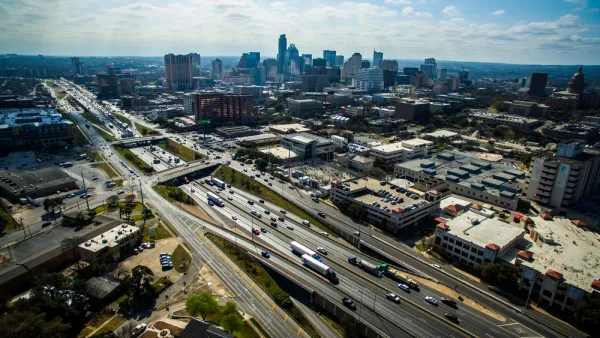A political decision by the Texas Transportation Commission last December to drop projects which included toll lanes was thought to doom 15 road expansions from their 10-year capital plan, but some will go forward with HOV as opposed to HOT lanes.

Last December, the Texas Transportation Commission, reacting to pressure from Gov. Greg Abbott and Lt. Gov. Dan Patrick to not spend funds from statewide propositions passed by voters in 2014 and 2015 on express lanes, voted 5-0 to eliminate 15 express lane projects from their 10-year capital plan. Neither ballot measures created new revenue. Instead, both divert existing funding streams (the state's Rainy Day Fund and sales taxes, respectively,) to roads and prohibit spending the revenue on toll lanes.
Ben Wear, who covers transportation for the Austin American-Statesman, reports that some projects will be expanded after all, though not as originally planned.
In a major departure from previously announced proposals, though, the $8.1 billion overhaul of I-35 through Central Texas would include the addition from Round Rock to Buda of nontolled managed lanes in each direction. In practice, that would mean high occupancy vehicle [HOV] lanes — sometimes referred to as carpool lanes — that only vehicles with at least two or perhaps three people aboard would be allowed to use.
The Texas Department of Transportation and local legislators had previously said the addition of lanes to I-35 would be possible financially only with tolls — and the borrowing that charging tolls allows. Now, TxDOT’s “unified transportation plan” [sic] for fiscal 2019 through fiscal 2028 assumes that the agency eventually will expand I-35 without charging tolls.
Motorists may be pleased to hear that "relief" is coming, but Wear reports that TxDOT lacks most of the funds. "How the agency will come up with the lion’s share of the I-35 project’s cost, and when, remains undetermined in this year’s version of the plan," he adds.
Implications beyond financing
Dropping the toll lanes, also known as express or TEXpress Lanes, means limiting access and forfeiting a valuable congestion management strategy. Depending on the roadway and time-of-day, carpools either received free or 50% discounted access to the toll lanes, also generically called high occupancy toll (HOT) lanes if they benefit carpoolers, which not all do.
Solo drivers can access the express lanes that utilize variable congestion-management pricing to ensure traffic speeds of at least 50 miles per hour. Solo drivers who access the carpool lanes risk a hefty fine, and the carpool lane itself will lack the management provided by dynamic tolling.
Extra revenue
TxDOT, "which had estimated it would get $770 million through Proposition 1 this year, instead will get about $1.3 billion, officials said, because of increasing oil prices and production," adds Wear.
Proposition 7 will direct state sales tax of $2.5 billion, a figure estimated to climb in the coming years, to TxDOT, and the agency now receives another $500 million or more each year in gasoline taxes that previously had been allocated to the Texas Department of Public Safety.
Another project Wear mentions is the U.S. 183 expansion in North Austin which would add two tolled lanes and one general purpose lane.
However, the plan now calls for the Central Texas Regional Mobility Authority to undertake the project on its own, with bonded debt.
Related posts:
-
Huge Toll Lane Setback in Texas: December 19, 2017In a landmark, unanimous vote, the Texas Transportation Commission eliminated all 15 express lane projects from their 10-year capital plan despite pleas from Austin area officials to retain the $8 billion, I-35 project that includes four toll lanes.
-
Interstate 35 through Central Austin would be transformed into a three-level roadway with toll lanes in the middle, according to an 8.1 billion vision proposed by TxDOT.
-
Big Expansion Approved for Austin-Area Highway: February 10, 2016The Transportation Policy Board of the Capital Area Metropolitan Planning Organization approved a big spending increase for a project to widen U.S. Highway 183.
Hat tip to IBTTA Smart Brief.
FULL STORY: TxDOT plan now foresees no tolls on I-35 expansion in Central Texas

National Parks Layoffs Will Cause Communities to Lose Billions
Thousands of essential park workers were laid off this week, just before the busy spring break season.

Retro-silient?: America’s First “Eco-burb,” The Woodlands Turns 50
A master-planned community north of Houston offers lessons on green infrastructure and resilient design, but falls short of its founder’s lofty affordability and walkability goals.

Delivering for America Plan Will Downgrade Mail Service in at Least 49.5 Percent of Zip Codes
Republican and Democrat lawmakers criticize the plan for its disproportionate negative impact on rural communities.

Test News Post 1
This is a summary

Test News Headline 46
Test for the image on the front page.

Balancing Bombs and Butterflies: How the National Guard Protects a Rare Species
The National Guard at Fort Indiantown Gap uses GIS technology and land management strategies to balance military training with conservation efforts, ensuring the survival of the rare eastern regal fritillary butterfly.
Urban Design for Planners 1: Software Tools
This six-course series explores essential urban design concepts using open source software and equips planners with the tools they need to participate fully in the urban design process.
Planning for Universal Design
Learn the tools for implementing Universal Design in planning regulations.
EMC Planning Group, Inc.
Planetizen
Planetizen
Mpact (formerly Rail~Volution)
Great Falls Development Authority, Inc.
HUDs Office of Policy Development and Research
NYU Wagner Graduate School of Public Service




























